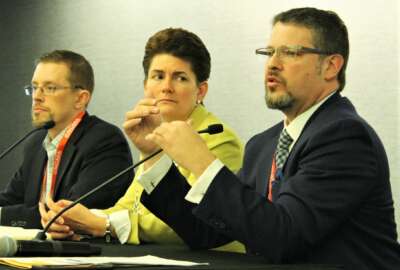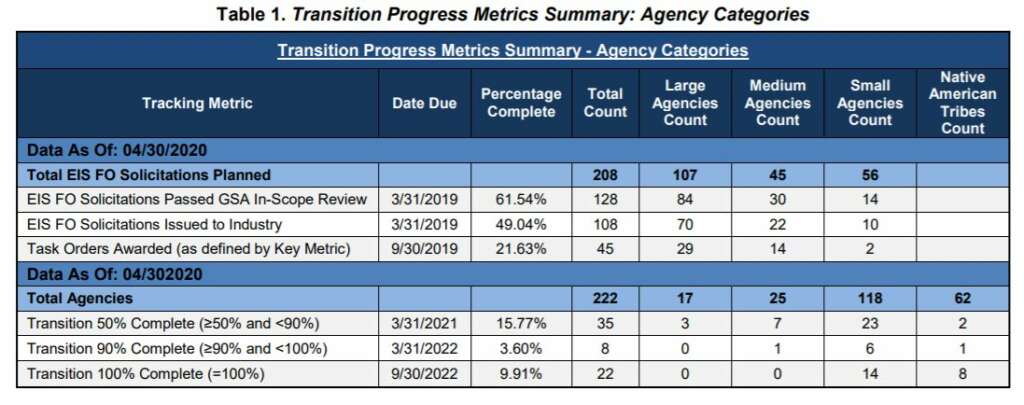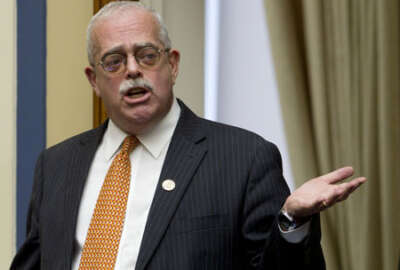

The General Services Administration says it’s creating more visibility into the transition to the Enterprise Infrastructure Solutions (EIS) program through...
If history is our best teacher, then the General Services Administration’s promise, even threat, of turning off telecommunications services of those agencies that don’t transition to the Enterprise Infrastructure Solutions (EIS) program by May 2023 may seem hollow.
With both of the previous two transitions, FTS 2001 and Networx, GSA made similar guarantees only to face the unspoken realization that the agency has all the responsibility but little authority to force agencies to change in a timely manner.
“It’s déjà vu all over again. It’s the same thing as we saw with Networx. GSA put a line in the sand, then another one and then said it would turn everyone off and agencies said no you’re not and you get into a standoff,” said one industry expert involved in federal telecommunications for much of the past 30 years, who requested anonymity because they didn’t get permission to speak to the press. “GSA has no teeth. They are trying their best, but there is no way to make these agency folks do stuff. What we ended up doing with FTS-2001 is GSA finally put stake in ground and were backed up by Congress and/or [the Office of Management and Budget]. They said no new extensions and here is the date certain that FTS 2001 will end. The day before the deadline, they instruct vendors to disconnect services. Vendors were no longer legally authorized to provide services and there were agencies that lost services.”
The expert and others say pressure from Capitol Hill and OMB may be the only way to make that deadline real.
“GSA has to have a carrot and stick approach to get agencies to move to EIS. The transition may be a bigger effort and may take longer than Networx did, but continuing to grow Networx is counter intuitive,” said Gary Wall, CEO of Coastal Communications Consulting Group and a former telecommunications branch chief for the Department of Health and Human Services. “One of the things that struck me is I’m concerned GSA will be overwhelmed with requests from agencies either for national security or emergency preparedness exceptions. GSA is in a tough position. They are trying to make the transition happen, but have no real authority to make agencies do what they need to do.”
The lack of authority is nothing new for GSA, which commonly is the implementation arm of OMB for technology and acquisition policies. This means there are other tools GSA has to pull out of its toolbox.
One of those tools is a recently posted EIS transition close out project plan, which detailed immediate actions GSA will take, deadlines associated with the effort and the process to limit use of legacy contracts.
“One of the major lessons learned in the transition to Networx is that increased visibility — especially at the executive level — is crucial to agencies’ progress. Without it, agencies’ transition teams don’t get the resources (human and financial) they need to gear up, sustain and complete their transition projects in a timely manner,” a GSA spokesperson said in response to questions from Federal News Network. “The closeout project focuses on candid and factual communications between executives at GSA and the agencies on whether agencies are making sufficient progress. The objective is not for GSA to unilaterally disconnect agencies’ services but to get them to transition themselves, with our support.”
The spokesperson said GSA continues to plan for a phased approach to move agencies off of the legacy contracts.
“GSA is taking its governmentwide role in transition seriously. If services are not transitioned successfully before the contracts expire, there will be no viable way to reinstate the services, which ultimately impacts agencies’ operations,” the spokesperson said. “The transition closeout plan is the implementation of the agreement between GSA and our customer agencies, which was established when the Infrastructure Advisory Group (IAG) requested GSA further extend the expiring contracts. GSA is taking a twofold approach to achieving 100% disconnection from legacy contracts. GSA will enforce the requirement to limit use of the extended contracts to those agencies who are meeting certain critical milestones (listed in the Transition Timeline) in order to be eligible to continue using the contracts. In addition, GSA will take steps to minimize the growth of services on the extended contracts by freezing contract modifications and orders for new services.”
But Wall and other experts say if OMB or Congress doesn’t step in when an agency demands more time to transition, history shows GSA doesn’t or can’t hold the line.
“I think it’s an OMB issue that they need to get involved with,” said the industry expert. “Congress isn’t interested because this is the most unsexy thing you could imagine so only the people with the money can fix this.”
Repeated requests to OMB asking about its oversight of the EIS program were not returned.
Members of the House Oversight and Reform Subcommittee on Government Operations pressed GSA in March about EIS and other initiatives. But since then, there has been little public interest in the program. Though the subcommittee is expected to hold two IT-focused hearings in July where a question or two about EIS would go a long way to sending a message to all agencies.
In responses to questions for the record to subcommittee chairman Gerry Connolly (D-Va.) after the March hearing, Bill Zielinski, who was the assistant commissioner of the Office of Information Technology Category in the Federal Acquisition Service at GSA, said the EIS Transition Team is tracking and analyzing 90 lessons learned from the Networx program.

Zielinski, who left that role in June to the Dallas city CIO, told then-subcommittee ranking member Mark Meadows (R-N.C.), who is now the White House chief of staff, that the Postal Service, the Securities and Exchange Commission and the Department of Homeland Security are facing the most challenges in moving to the EIS program.
“For the USPS, staffing shortages combined with an extensive internal approval process delayed the submission of its statement of work to GSA for scope review. The USPS currently plans to award their two EIS task orders by September 30, 2020. Following its task order awards, the USPS will have to transition its large inventory of over 170,000 services off the extended contracts and onto EIS,” Zielinski wrote. “The SEC is addressing funding issues which are planned to be resolved this fiscal year. The SEC plans to award four of its six task orders by the end of fiscal year 2020.”
Meanwhile, he said FEMA may not award its EIS task order until early 2022, while GSA expects most of the other components to award sometimes between the first and third quarters of 2021.
“Executive leadership at GSA is actively engaging with the chief information officers of these components to emphasize the risks associated with a delayed transition and to discuss opportunities for making a more timely transition,” Zielinski wrote.
That approach of “active engagement” is the GSA’s best, and really only, tool to get agencies moving.
The GSA spokesperson said Administrator Emily Murphy briefed the President’s Management Council and sent individual letters to 38 deputy secretaries or their equivalents stressing the importance of attention to the transition schedule in November 2019.
In March 2020, Zielinski sent a letter to each agency transition sponsor and over 500 other agency contacts notifying them that in order to continue using the extended contracts, they must make progress on their transition.
Most recently, Allen Hill, acting deputy assistant commissioner for Category Management, sent individual progress notices to CIOs at 35 agencies.
GSA briefed the IAG multiple times in between July 2019 and March 2020 on the phased approach that became the foundation of the plan. GSA also offered the same briefing to 150 representatives from smaller agencies in February 2020.
In a recent interview with Federal News Network, Hill said EIS is gaining momentum every month.

Hill said GSA also has been asking agencies how the coronavirus pandemic has impacted EIS transition.
“So far only five agencies formally reported impacts to their transition,” Hill said. “For those agencies that make those task order awards and are impacted, we work with those agencies to mitigate any delays as a result of that activity. The pandemic response demonstrates how important it is to modernize the federal networks to be able to support a mobile workforce. It’s also helped them identify some gaps that they are now going back and addressing those gaps because of what happened.”
Coastal Communication’s Wall said agencies need to be more strategic in their transitions and look for opportunities to make significant progress.
“It’s not necessarily going after the low-hanging fruit. They have to work on hard projects like advanced data networks because you can’t wait until the last minute as they tend to take longer to transition,” he said. “The other thing they need to do is continually refine their transition inventories. It’s something that sounds like it’s easy, but it can’t be overstated the importance because that is what you measure your transition success on.”
There is a cost to keeping your inventories up to date, to tracking your progress and for all the things that go with the transition. Agency budgets and resources tend to be stretched thin as is, which is why OMB’s active involvement is the only way GSA’s promise to turn off services will work.
Copyright © 2025 Federal News Network. All rights reserved. This website is not intended for users located within the European Economic Area.
Jason Miller is executive editor of Federal News Network and directs news coverage on the people, policy and programs of the federal government.
Follow @jmillerWFED



